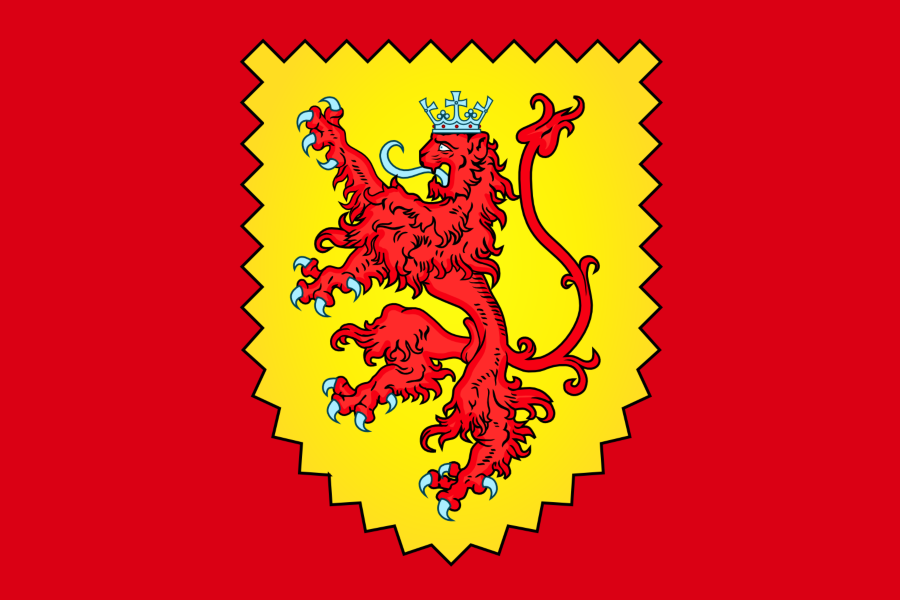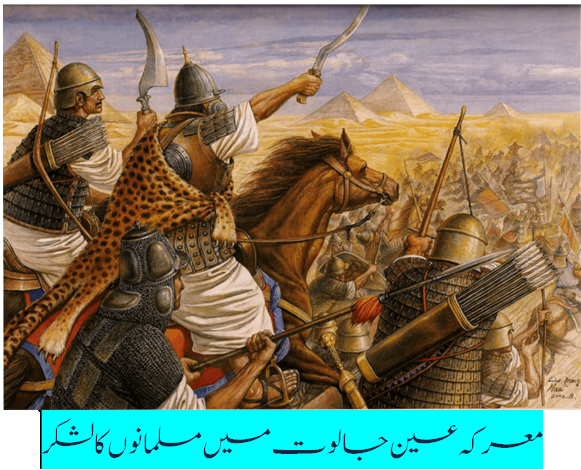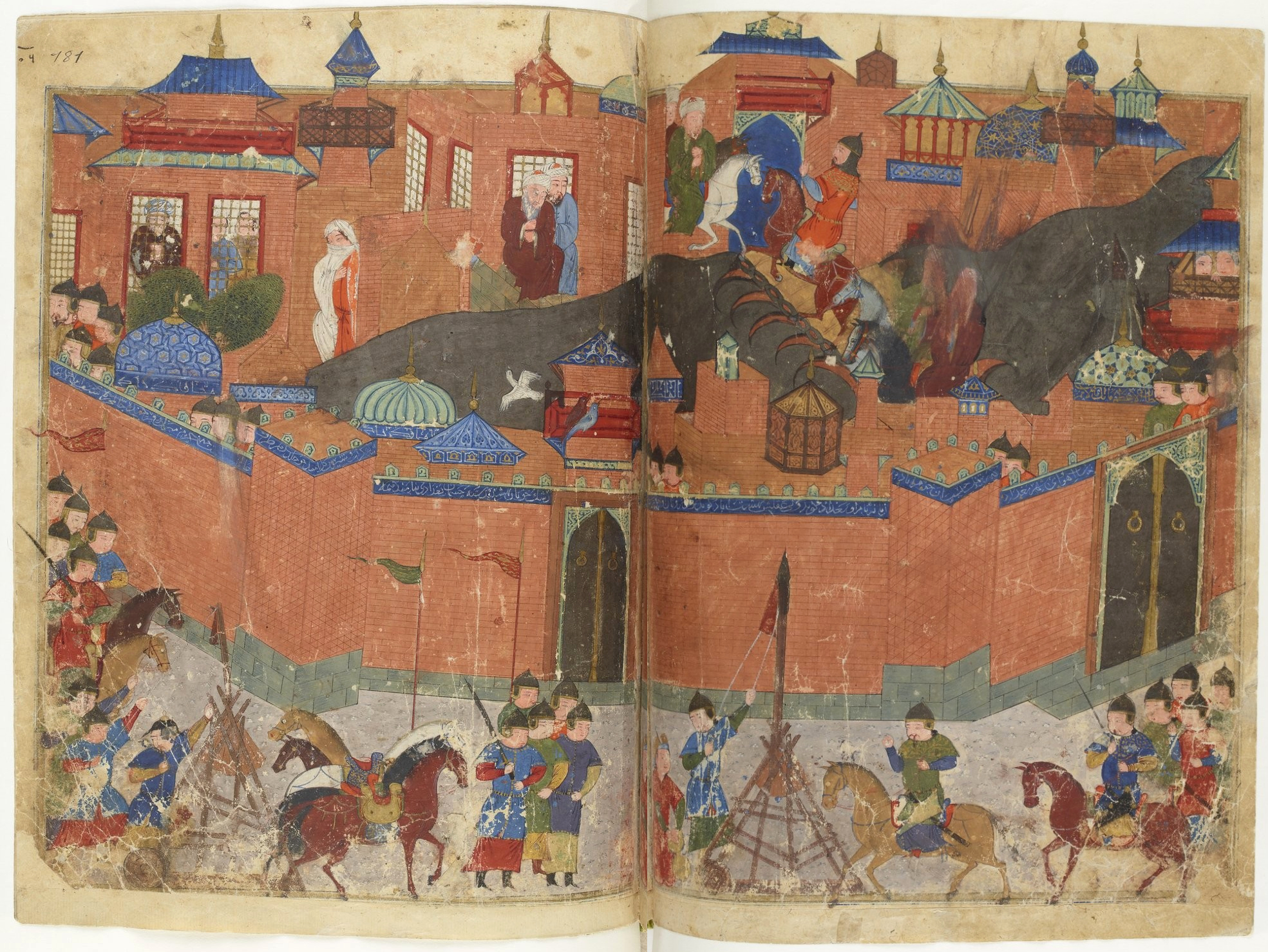|
Sunqur Al-Ashqar
Shams al-Din Sunqur al-Ashqar al-Salihi ( ar, شمس الدين سنقر الأشقر الصالحي) was the Mamluk viceroy of Damascus in 1279–1280, who attempted to rule Syria independently, in a rebellion against the Egypt-based sultan Qalawun (). While the rebellion in Damascus was quashed in 1280, Sunqur ensconced himself in the Sahyun Castle in the coastal mountains of northern Syria. He joined Qalawun in the successful defense of Syria against the Ilkhanid Mongols at the Battle of Homs in 1281. He remained in a state of peaceful relations with the sultan, despite ruling his coastal principality independently. Sunqur's rule came to an end with the capture of Sahyun by Qalawun's deputy Turuntay in 1287. Sunqur returned to Cairo, where he was given the highest military ranks and considerable honors and benefits by Qalawun. The latter's son and successor, al-Ashraf Khalil () imprisoned Sunqur and had him executed in 1293 for defying his orders to hand over part of the wea ... [...More Info...] [...Related Items...] OR: [Wikipedia] [Google] [Baidu] |
Mamluk Sultanate
The Mamluk Sultanate ( ar, سلطنة المماليك, translit=Salṭanat al-Mamālīk), also known as Mamluk Egypt or the Mamluk Empire, was a state that ruled Egypt, the Levant and the Hejaz (western Arabia) from the mid-13th to early 16th centuries. It was ruled by a military caste of mamluks (manumitted slave soldiers) headed by the sultan. The Abbasid caliphs were the nominal sovereigns. The sultanate was established with the overthrow of the Ayyubid dynasty in Egypt in 1250 and was conquered by the Ottoman Empire in 1517. Mamluk history is generally divided into the Turkic or Bahri period (1250–1382) and the Circassian or Burji period (1382–1517), called after the predominant ethnicity or corps of the ruling Mamluks during these respective eras.Levanoni 1995, p. 17. The first rulers of the sultanate hailed from the mamluk regiments of the Ayyubid sultan as-Salih Ayyub (), usurping power from his successor in 1250. The Mamluks under Sultan Qutuz and Baybars rou ... [...More Info...] [...Related Items...] OR: [Wikipedia] [Google] [Baidu] |
Aybak
Izz al-Din AybakThe name Aybeg or Aibak or Aybak is a combination of two Turkic words, "Ay" = Moon and "Beg" or variant "Bak" = Emir in Arabic. -(Al-Maqrizi, Note p.463/vol.1 ) ( ar, عز الدين أيبك) (''epithet:'' al-Malik al-Mu'izz Izz al-Din Aybak al-Jawshangir al-Turkmani al-Salihi, ar, links=no, الملك المعز عز الدين أيبك التركماني الجاشنكير الصالحى) was the first of the Mamluk sultans of Egypt in the Turkic Bahri line.Though Aybak is regarded by historian as a Mamluk, he actually served in the court of as-Salih Ayyub as an Emir/military commander and not as a Mamluk.- Shayal, p. 153/ vol.2- Al-Maqrizi, p. 463/vol.1 – According to Ibn Taghri as-Salih Ayyub bought him before he became a Sultan and he promoted him to the position an Emir. The rank which Aybak used was of a Khawanja (خوانجا Sultan's accountant ). Ibn Taghri, PP.103-273/ The Sultanate of al-Muizz Aybak al-Turkumani.Some historians, however, consider S ... [...More Info...] [...Related Items...] OR: [Wikipedia] [Google] [Baidu] |
Hethum I, King Of Armenia
Hethum I (Armenian: Հեթում Ա; 1213 – 21 October 1270) ruled the Armenian Kingdom of Cilicia (also known as "Little Armenia") from 1226 to 1270. He was the son of Constantine of Baberon (d. 1263) and Princess Alix Pahlavouni of Lampron (a third-cousin of Leo I) and was the founder of the dynasty which bears his name: the Hetհumids. Having accepted the suzerainty of the Mongol Empire, Hethum himself traveled to the Mongol court in Karakorum, Mongolia, a famous account of which is given by Hethum's companion, the historian Kirakos Gandzaketsi, in his ''History of Armenia''. Family Hethum's father Constantine had been regent for the young Isabella, Queen of Armenia. Isabella originally married Philip (1222–1225), son of Bohemond IV of Antioch. However, Constantine had Philip disposed of, and instead forced Isabella to marry his own son, Hethum, on June 14, 1226, to make Isabella and Hethum co-rulers. The couple had six children: # Leo II (died 1289) # Thoros (died at the ... [...More Info...] [...Related Items...] OR: [Wikipedia] [Google] [Baidu] |
Leo II, King Of Armenia
Leo II or Leon II (occasionally numbered Leo III; , ''Levon II''; c. 1236 – 1289) was king of the Armenian Kingdom of Cilicia, ruling from 1269''Cambridge Medieval History'', Volume IV, p. 634/1270 to 1289. He was the son of King Hetoum I and Queen Isabella and was a member of the Hetoumid family. Early life Leo was born in 1236, the son of King Hetoum I and Queen Isabella. Hetoum and Isabella's marriage in 1226 had been a forced one by Hetoum's father Constantine of Baberon, who had arranged for Queen Isabella's first husband to be murdered so as to put Constantine's own son Hetoum in place as a co-ruler with Isabella. They had six children, of which Leo was the eldest. One of his sisters was Sibylla of Armenia, who was married to Bohemond VI of Antioch to bring peace between Armenia and Antioch. In 1262, Leo married Keran (Kir Anna), the daughter of Prince Hetoum of Lampron. In 1266, while their father king Hetoum I was away to visit the Mongol court, Leo and his ... [...More Info...] [...Related Items...] OR: [Wikipedia] [Google] [Baidu] |
Cilician Armenia
The Armenian Kingdom of Cilicia (Middle Armenian: , '), also known as Cilician Armenia ( hy, Կիլիկեան Հայաստան, '), Lesser Armenia, Little Armenia or New Armenia, and formerly known as the Armenian Principality of Cilicia ( hy, Կիլիկիայի հայկական իշխանութիւն), was an Armenian state formed during the High Middle Ages by Armenian refugees fleeing the Seljuk invasion of Armenia., pp. 630–631. Located outside the Armenian Highlands and distinct from the Kingdom of Armenia of antiquity, it was centered in the Cilicia region northwest of the Gulf of Alexandretta. The kingdom had its origins in the principality founded c. 1080 by the Rubenid dynasty, an alleged offshoot of the larger Bagratuni dynasty, which at various times had held the throne of Armenia. Their capital was originally at Tarsus, and later became Sis. Cilicia was a strong ally of the European Crusaders, and saw itself as a bastion of Christendom in the East. It also s ... [...More Info...] [...Related Items...] OR: [Wikipedia] [Google] [Baidu] |
Battle Of Mari
The Battle of Mari, also called the Disaster of Mari, was a battle between the Mamluks of Egypt and the Armenians of Cilician Armenia on 24 August 1266. Battle The conflict started when the Mamluk Sultan Baibars, seeking to take advantage of the weakened Mongol domination, sent a 30,000 strong army to Cilicia and demanded that Hethum I of Armenia abandon his allegiance to the Mongols, accept himself as a suzerain, and give to the Mamluks the territories and fortresses Hetoum has acquired through his alliance with the Mongols. At the time however, Hetoum I was in Tabriz, having gone to the Mongol court of the Il-Khan in Persia to obtain military support. During his absence, the Mamluks marched on Cilician Armenia, led by Al-Mansur Ali and the Mamluk commander Qalawun. Hetoum I's two sons, Leo (the future king Leo II) and Thoros, led the defense by strongly manning the fortresses at the entrance of the Cilician territory with a 15,000 strong army. The confrontation took place ... [...More Info...] [...Related Items...] OR: [Wikipedia] [Google] [Baidu] |
Battle Of Ain Jalut
The Battle of Ain Jalut (), also spelled Ayn Jalut, was fought between the Bahri Mamluks of Egypt and the Mongol Empire on 3 September 1260 (25 Ramadan 658 AH) in southeastern Galilee in the Jezreel Valley near what is known today as the Spring of Harod (). The battle marked the height of the extent of Mongol conquests, and was the first time a Mongol advance was permanently beaten back in direct combat on the battlefield. Continuing the westward expansion of the Mongol Empire, the armies of Hulagu Khan captured and sacked Baghdad in 1258, along with the Ayyubid capital of Damascus sometime later. Hulagu sent envoys to Cairo demanding Qutuz surrender Egypt, to which Qutuz responded by killing the envoys and displaying their heads on the Bab Zuweila gate of Cairo. Shortly after this, Möngke Khan was slain in battle against the Southern Song. Hulagu returned to Mongolia with the bulk of his army to attend the kurultai in accordance with Mongol customs, leaving appro ... [...More Info...] [...Related Items...] OR: [Wikipedia] [Google] [Baidu] |
Qutuz
Saif ad-Din Qutuz ( ar, سيف الدين قطز; died 24 October 1260), also romanized as Kutuz or Kotuz and fully al-Malik al-Muẓaffar Sayf ad-Dīn Quṭuz (), was a military leader and the third or fourth of the Mamluk Sultans of Egypt in the Turkic line. He reigned as Sultan for less than a year, from 1259 until his assassination in 1260, but served as the de facto ruler for two decades. Sold into slavery in Egypt, he rose to become vice-Sultan for over 20 years, becoming the power behind the throne. He was prominent in defeating the Seventh Crusade, which invaded Egypt in 1249–50. When Egypt was threatened by the Mongols in 1259, he took control of the military and deposed the reigning Sultan, 15-year-old Sultan Al-Mansur Ali. The centers of Islamic power in Syria and Baghdad were conquered by the Mongols, and the center of the Islamic Empire moved to Egypt, which became their next target. Qutuz led an Egyptian Mamluk army north to confront the Mongols, having ... [...More Info...] [...Related Items...] OR: [Wikipedia] [Google] [Baidu] |
Siege Of Aleppo (1260)
The siege of Aleppo lasted from 18 January to 24 January 1260. After receiving the submission of Harran and Edessa, Mongol leader Hulagu Khan crossed the Euphrates, sacked Manbij and placed Aleppo under siege. He was supported by forces of Bohemond VI of Antioch and Hethum I of Armenia. For six days the city was under siege. Assisted by catapults and mangonels, Mongol, Armenian and Frankish forces overran the entire city, except for the citadel which held out until 25 February and was demolished following its capitulation. The ensuing massacre, that lasted six days, was methodical and thorough, in which nearly all Muslims and Jews were killed, though most of the women and children were sold into slavery. Also included in the destruction, was the burning of the Great Mosque of Aleppo. Following the siege, Hulagu had some of Hethum's troops executed for burning the mosque, Some sources state Bohemond VI of Antioch (leader of the Franks) personally saw to the mosque's destruction.A ... [...More Info...] [...Related Items...] OR: [Wikipedia] [Google] [Baidu] |
Mongol Invasion Of Syria
Starting in the 1240s, the Mongols made repeated invasions of Syria or attempts thereof. Most failed, but they did have some success in 1260 and 1300, capturing Aleppo and Damascus and destroying the Ayyubid dynasty. The Mongols were forced to retreat within months each time by other forces in the area, primarily the Egyptian Mamluks. Since 1260, it had been described as the Mamluk–Ilkhanid War. First invasion During the governorship of Bachu in Persia, the Mongolian army under Yisaur attacked Syria in 1244. The reasons for the attack are unclear, but it may have been in retaliation for the Syrian participation on the Seljuk side in the Battle of Köse Dağ. In the autumn 1244, Yisaur concentrated the Mongol forces in the upper Tigris valley where they subjugated the Kurdish province of Akhlat. Moving across, the Mongolian army encountered no resistance and ravaged the area en route. The fortified cities were untaken in his advance because Yisaur was not prepared for siege a ... [...More Info...] [...Related Items...] OR: [Wikipedia] [Google] [Baidu] |
Al-Nasir Yusuf
An-Nasir Yusuf ( ar, الناصر يوسف; AD 1228–1260), fully al-Malik al-Nasir Salah al-Din Yusuf ibn al-Aziz ibn al-Zahir ibn Salah al-Din Yusuf ibn Ayyub ibn Shazy (), was the Ayyubid Emir of Syria from his seat in Aleppo (1236–1260) and the Sultan of the Ayyubid Empire from 1250 until the sack of Aleppo by the Mongols in 1260. Background An-Nasir Yusuf was the great-grandson of Saladin. He became the Ayyubid ruler of Aleppo when he was seven-years-old after the death of his father Al-Aziz Muhammad. He was placed under a four-man regency council, consisting of the vizier Ibn al-Qifti, the emir Shams al-Din Lu'lu' al-Amini, the emir 'Izz al-Din 'Umar ibn Mujalli and Jamal al-Dawla Iqbal. The last was the representative of an-Nasir's grandmother, Dayfa Khatun, daughter of Al-Adil I, who was the effective ruler until her death in 1242. Thereafter until his death in 1251, Shams al-Din was an-Nasir's commander-in-chief and most influential advisor. His most ... [...More Info...] [...Related Items...] OR: [Wikipedia] [Google] [Baidu] |
Baybars
Al-Malik al-Zahir Rukn al-Din Baybars al-Bunduqdari ( ar, الملك الظاهر ركن الدين بيبرس البندقداري, ''al-Malik al-Ẓāhir Rukn al-Dīn Baybars al-Bunduqdārī'') (1223/1228 – 1 July 1277), of Turkic Kipchak origin, commonly known as Baibars or Baybars ( ar, بيبرس, ''Baybars'') – nicknamed Abu al-Futuh (; English: ''Father of Conquests'', referring to his victories) – was the fourth Mamluk sultan of Egypt and Syria in the Bahri dynasty, succeeding Qutuz. He was one of the commanders of the Egyptian forces that inflicted a defeat on the Seventh Crusade of King Louis IX of France. He also led the vanguard of the Egyptian army at the Battle of Ain Jalut in 1260, which marked the first substantial defeat of the Mongol army and is considered a turning point in history. The reign of Baybars marked the start of an age of Mamluk dominance in the Eastern Mediterranean and solidified the durability of their military system. He managed to pa ... [...More Info...] [...Related Items...] OR: [Wikipedia] [Google] [Baidu] |






